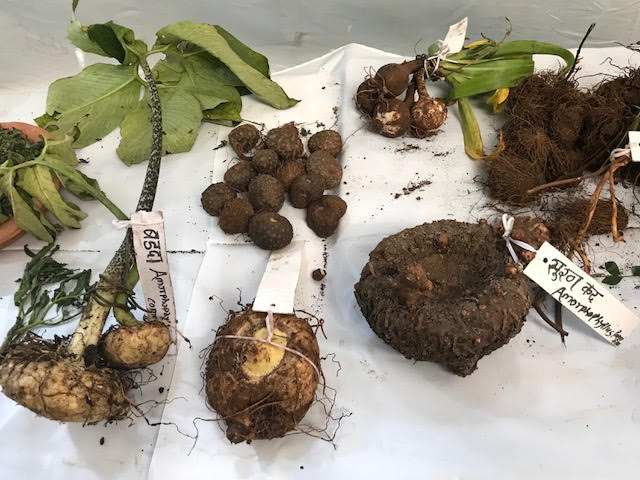Forest Vegetables (Raan Bhaaji) Festival in Mumbai
Exactly a year ago,my friend Bimba and I saw an announcement about foraging in the forest with locals and then having a meal with them.This was about three hours away from Mumbai and we were pretty excited by the whole concept.The mountain air,the lush vegetation and the thrill of discovering something new,all seemed to beckon.Unfortunately it rained very,very heavily and the thought of poor network connectivity in such a situation made us give up our adventure.
When I saw the announcement for "Wild Foods Festival" by BAIF and OOO Farms,few days ago,my joy knew no bounds.The mountain had arrived in Mumbai!
Inspite of the ongoing Ganpati festival,the Rotary Centre hall at Juhu was packed with people of all ages.At first we saw a video on forest foraging and how the locals cooked.I know I want to do this someday.Whether in the forests in Coorg (of which Megha Deokule spoke of at the Archaeobroma (Archaeology of Food) conference some months ago) or Maharashtra,I don't know.But I will.
Tribal women came from Sahyadris,Bhandardhara,Akola and other places to present their fare to the urban folk of Mumbai.They searched their forests for produce to make dishes that were unique,tasty and healthy.Produce that is called "Raan Bhaaji".They started cooking at 3 am so that we could have their exceptional cuisine for lunch
The event had a display of their tools and kitchen utensils.The Mortar and Pestle as well as the Vidi is what they use for cooking.There was also Warli artwork.
Different types of rice including Sahyadri Black Rice that is creating waves
Millets such as Finger millet,Foxtail Millet,Proso Millet,Pearl Millet,Little Millet and Kodo Millet are good sources of nutrition and are indigenous foods.
I had read about different colours of corn in America such as purple corn, blue corn and yellow corn I was pleasantly surprised to see multiple colors in corn the exhibition had and to hear from Mr Patil that corn had existed a long,long time in India.
Mr Patil showed us many plants and there were more in the exhibition area.He outlined ways in which they are cooked by tribals and what additional health benefit they had.He discussed plants like Kadu Kand,Bhokar,Kartuli,Kavadar,Kakad,Kharsing and Mahua.The Mahua tree is considered Kalpavriksha by the tribals.They use flowers,seeds,fruits,seeds and its oil.He spoke about the use of tubers in tribal diet and the advantages of slow release carbohydrates.He told us about plants tribals ate to survive the drought.We were all given booklets with indigenous recipes
An 82 year old man played an instrument called Tarpa made from Horn.Only a few people know this art.He is from Jawahar Taluka and stated the music is said to make crops prosper.
The welcome drink was Wild Tea made with mountain herbs including lemongrass.
There was a Tasting Station with wild vegetables of all sorts.
For lunch,we had ....hold your breath....Mahua Koshimbir (salad),Niger Seed Chutney which was exquisite,millet bhakri,sorghum bhakri,mountain lentils,Sahyadri Black Rice and Sahyadri Ambemohar
Dessert was Mahua Halwa.....moong dal and mahua flower,wonderfully matched!
We also had the Ambil which is sour and soup like,a mountain malt
In the interest of sustainability,we need to consider other food sources that are nutritious and locally grown.There were lectures by Ajinkya Hunge of Two Brothers Organic Farms (near Sholapur) and the Khandelwals of OOO Farms which is in the Sahyadris.They spoke of the role of microbes in soil stabilization and the value of forest produce.They spoke about the concept of sustainable agriculture.These are points worth pondering on.If we are to leave something for future generations,we must start now




















Comments